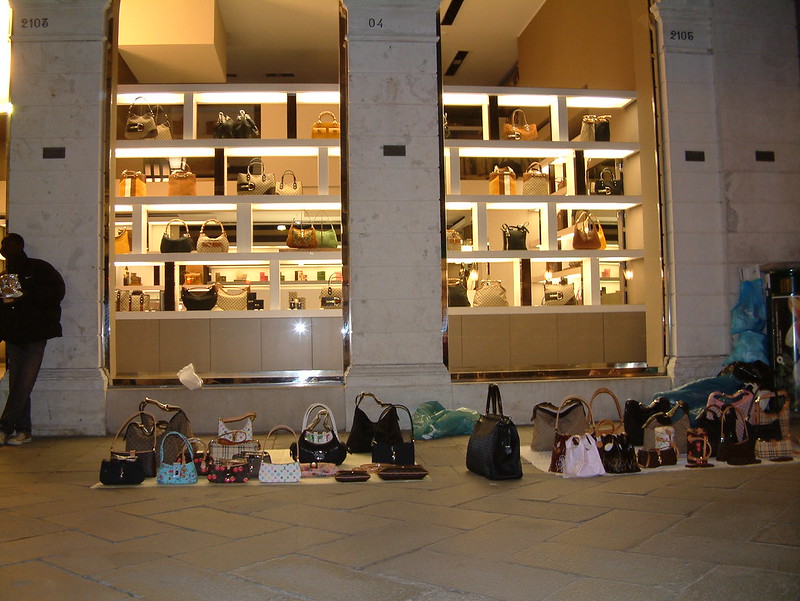As the US and China escalate their trade war, increasingly imposing new tariffs on each other’s goods, there is another factor in the US-China economic relationship that receives little attention, but is causing serious harm to the US economy and national security: the sale of counterfeit goods.
Trade in counterfeit and pirated goods is estimated to represent 3.3% of world trade, and this figure is rising. Counterfeit goods present a national security threat to the health and safety of the public and undermine the prosperity and competitiveness of economies, not just in the US, but around the world. They also pose a risk to the military and critical infrastructure supply chain. The UN states that there is a strong connection between transnational organised crime and the trafficking of counterfeit goods, which generates hundreds of billions of dollars for the criminals and deprives countries of tens of billions in revenue.
China and Hong Kong account for 87% of the $600-900 billion in counterfeit goods trafficked by transnational organised criminal networks to the US, far more than the $539.5 billion in goods the US imported from China in 2018.
In Europe, almost 7% of EU imports (worth $134 billion) are counterfeit and pirated goods
In Europe, almost 7% of EU imports (worth $134 billion) are counterfeit and pirated goods. France, Italy, Germany, the UK and Spain are the most impacted. China and Hong Kong are responsible for producing 70% of the counterfeit goods there.
Statistics show that current efforts to combat counterfeiting are woefully inadequate. Seizures by customs officials are alarmingly low, by some estimates as little as 2.5% of the value of total estimated counterfeits. Despite transnational criminal organisations rapidly expanding the scope and scale of trafficked counterfeit goods, law enforcement seizures have remained low and stable. The US Intellectual Property Rights Center (IPRC) reports that the US Customs and Border Protection and Homeland Security Investigations interdicts approximately $1.5 billion of counterfeit goods each year. For the past five years, the IPRC reported that the value of goods seized each year was between $1.2 billion and $1.5 billion. In fiscal year 2018, for example, the value of seized goods was nearly $1.4 billion. The number of seizures, arrests, indictments and convictions do not appreciably change from year to year with the volume, value and variety of counterfeit goods entering the US.
Criminals are far outpacing law enforcement efforts. In 2018, just one operation alone in New York City accounted for nearly half the amount of the entire year’s seizures – $450 million – and the arrest of nearly two dozen people. This investigation took six years. At this rate, the traffickers will continue to far outpace law enforcement efforts.
Criminals are far outpacing law enforcement efforts
With the estimated trafficking of counterfeit goods expected to top $1.8 trillion in 2020, clearly more needs to be done.
The White House has taken some steps. In April, it issued a memo on Combating Trafficking in Pirated and Counterfeit Goods. A report has been commissioned calling on federal agencies to provide recommendations to combat the issue; it is due at the end of October.
But more needs to be done. There are several ways to improve efforts to combat the growing counterfeit threat. First, invest in the personnel and expertise to combat the expanding online and darkweb sale of counterfeit goods. One of the biggest shifts by criminals globally is the sale of counterfeit goods marketed over eCommerce platforms. This cyber-enabled crime has increased the reach of transnational criminals. These goods are increasingly shipped in express consignment or postal service packages, which are harder to detect. Senior US officials have expressed the need to target trafficking through third-party online marketplaces and noted there is a more than 40% chance that any brand name product bought through these online marketplaces today could be counterfeit.
Second, one of the most important ways law enforcement can improve their response is to increase information-sharing among agencies and international law enforcement partners. Too often, law enforcement considers the network disrupted after a domestic arrest, yet the international component of the crime group continues to operate and reconstitute. For example, when one takedown occurs, such as the New York operation, the data from the arrests on tactics, methods, contacts and sources of counterfeits should be shared among agencies to build knowledge, enhance existing data, build bigger cases and disrupt wider networks. One study found criminals engaged in counterfeiting are often engaged in a range of other crimes with links to organised crime, thereby presenting additional opportunities for law enforcement to disrupt the illicit activity and wider networks.
One study found criminals engaged in counterfeiting are often engaged in a range of other crimes
Third, improve information-sharing among stakeholders in the public and private sector. Law enforcement do partner with some private sector entities, and these partnerships help focus resources on some larger trafficking organisations. This is partly successful, but only a small percentage of industry become partners with the US government. Rather than order private industry to cooperate, law enforcement should proactively share more information with industry to equip it with needed intelligence and the tools to take action against online criminal activity. Some US officials have called for increased investments and partnerships to mine big data. The US even acquired an agreement by China to ‘explore the use of big data and other new information technologies to enhance the capability for combating infringement and counterfeiting online’. Advanced technical solutions, such as using artificial intelligence to root out illicit transactions and coordinated action between the public and private sectors in the eCommerce sphere, are critical.
Finally, the US must expand international cooperation. This includes working with, and pressuring if necessary, governments of countries from which the majority of counterfeit goods originate – namely China and Hong Kong and countries which are also threatened by the rise in counterfeit goods entering the supply chain. Just this year, Vietnam stopped the illegal transfer of fake product-origin certificates – an effort by Chinese manufactures to dodge US tariffs.
Bonnie E. Mitchell. A veteran of the US Intelligence Community, Bonnie Mitchell presently serves at the Program Manager for the Brand and Consumer Protection Program at the National Cyber-Forensics and Training Alliance (NCFTA), a non-profit corporation focused on identifying, mitigating and neutralizing cybercrime threats globally.
Main image credit: guydickinson, via Flickr.
The views expressed in this article are those of the author(s) and do not necessarily reflect the views of RUSI or any other institution.



